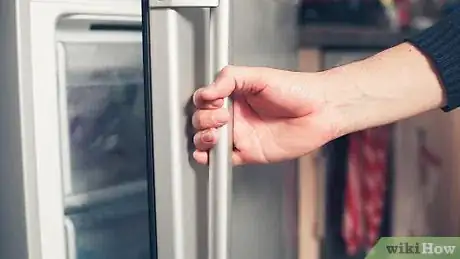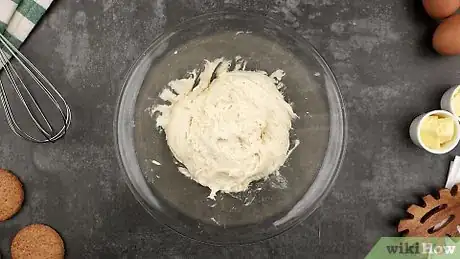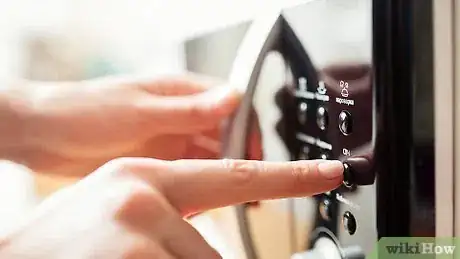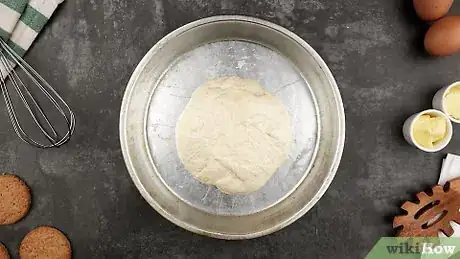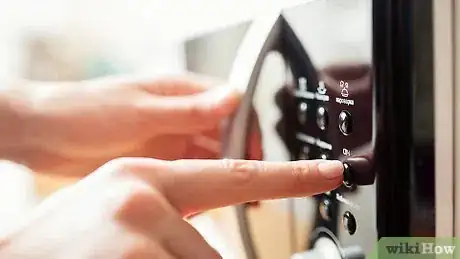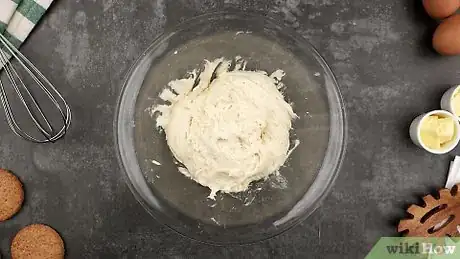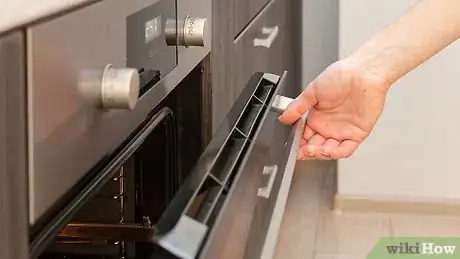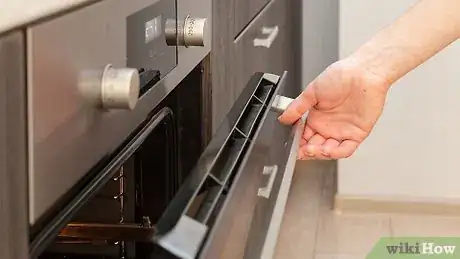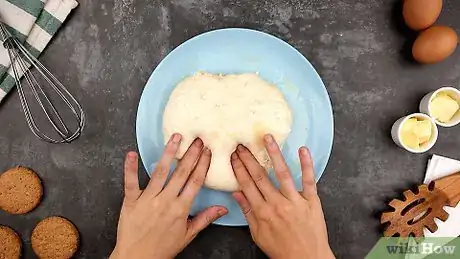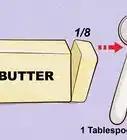This article was co-authored by wikiHow Staff. Our trained team of editors and researchers validate articles for accuracy and comprehensiveness. wikiHow's Content Management Team carefully monitors the work from our editorial staff to ensure that each article is backed by trusted research and meets our high quality standards.
The wikiHow Video Team also followed the article's instructions and verified that they work.
This article has been viewed 106,254 times.
Learn more...
Frozen dough is very easy to defrost and you can use a number of various methods to thaw it. Defrost any type of dough using a microwave, a fridge, or an oven. If you're in a hurry, the microwave is your best bet to quickly defrost your dough. The fridge will take the longest but requires the smallest amount of effort. Using the oven will ensure a thorough thaw but takes much longer than the microwave.
Steps
Using a Fridge
-
1Put cooking spray on a pan. Lay a pan flat on a clean work surface. Use a bottle of cooking spray and squirt it across the surface of the pan. The dough will rise to double its size in the fridge so make sure that your pan is big enough for this expansion.[1]
- You can also make your own cooking spray. Buy a spray bottle and fill it with canola, olive, or another type of oil and use that on your pan instead.
-
2Wrap the dough in plastic wrap and place it on the pan. Coat your plastic wrap with cooking spray. Tightly wrap the plastic around the dough on the pan. Spraying the plastic wrap will stop the dough from sticking to it when it rises.[2]Advertisement
-
3Put your pan in the refrigerator and leave it overnight. Ensure the dough has enough room to double its original size. If your pan is too big for the shelves, pull the shelf out of the fridge and place it on a lower groove on the inside wall of the fridge.[3]
- If you don't have the time to leave the dough in the fridge overnight, you can leave it in there during the day for 8 hours or so.
-
4Leave the dough rise at room temperature if you need to. If you think the dough still needs to rise a bit more, remove the plastic wrap and leave it on the worktop in your kitchen. Allow it to rise for 30-60 minutes.[4]
- You can preheat your oven while the dough rises at room temperature.
-
5Bake your dough. Once your dough has risen to double in size, you can bake it in your oven as the recipe indicates. Inspect it to make sure it doesn't look or feel frozen before you place it in the oven.
Thawing with a Microwave
-
1Coat a microwave-safe plate with cooking spray. You can use store-bought cooking spray or make your own cooking spray by filling a spray bottle with your favorite type of oil. Make sure you clean the spray bottle beforehand.[5]
-
2Place your frozen dough on the plate and cover it with plastic wrap. Take your frozen dough out of the freezer. Place it directly on the microwave plate coated in cooking spray. Before you place the plastic wrap over the dough, squirt the wrap with cooking spray. This will make sure the dough doesn't stick to it.[6]
- Wind the plastic wrap tightly around the dough.
-
3Microwave the dough on high for 25 seconds. The high setting on your microwave will heat the dough but it won't cook it in 25 seconds. When the 25 seconds are up, take the dough out of the microwave.
-
4Flip the dough over and microwave it for another 25 seconds. Ensure that all the dough is covered in plastic wrap before microwaving it again. When the time is up, remove the dough from the microwave and place it on a clean work surface.[7]
-
5Remove the plastic wrap and inspect your dough. Tear off the plastic wrap and put it in the trash. Look at and touch your dough to check how frozen it is. It should still feel cool to the touch, but it shouldn't be hard.[8]
- It's also unlikely that the dough will have risen a significant amount.
-
6Microwave the dough on defrost for 3 to 5 minutes. The defrost setting will evenly defrost your dough.[9]
- Generally, a smaller amount of dough will need around 3 minutes to defrost in the microwave and a larger amount of dough will take closer to 5 minutes to defrost.
-
7Leave the dough out at room temperature for an hour to rise. Once your dough is finished defrosting in the microwave, take it out and place it on a work surface. Leaving it out at room temperature will give the dough plenty of time to properly rise.[10]
- Once the dough has risen enough, place it in the oven and bake it as per the recipe.
Defrosting with an Oven
-
1Squirt cooking spray on a bowl or baking pan. Make sure that your cooking pan or bowl is large enough to support the dough once it rises to twice its frozen size.[11]
- Use cooking spray you bought in a store or fill a spray bottle with your favorite type of oil.
-
2Place the dough in the pan and cover it with plastic wrap. Coat the plastic wrap first with your cooking spray to make sure the dough doesn't stick to it when it rises.[12]
- Wrap the plastic tightly around the dough to ensure it's properly heated when it's put it in the oven.
-
3Put the pan in the oven at 100 °F (38 °C). If you have a gas oven, put the heating on the lowest gas mark. Some ovens have a "bread proofing" setting, which will set the temperature to 100 °F (38 °C). This temperature is the perfect heat for defrosting frozen dough.[13]
-
4Take the pan out of the oven after 1 hour to test it. When the time is up, put on oven gloves and remove the pan from the oven. Take the plastic wrap off the dough and inspect it to see if the dough has fully defrosted and risen.[14]
-
5Put the dough back in the oven for 30 mins to 1 hour if it's not fully defrosted. If the dough hasn't risen to twice its size, it may need more time. Rewrap the dough in plastic wrap before putting it back in the oven.[15]
- If the dough has risen a small amount, you should put it back in for 30 minutes. If it hasn't risen at all, put it back in for another hour.
-
6Remove the plastic wrap before baking the dough as the recipe indicates. When the time is up, remove the plastic wrap and place the dough on your work surface. Then, put it on a clean pan and bake it following the instructions in your specific recipe.[16]
Things You'll Need
Using a Fridge
- Fridge
- Cooking spray
- Plastic wrap
- Pan
Thawing with a Microwave
- Microwave
- Microwave plate
- Cooking spray
- Plastic wrap
Defrosting with an Oven
- Gas or electric oven
- Large pan or bowl
- Cooking spray
- Plastic wrap
- Oven gloves
References
- ↑ https://www.thekitchn.com/how-to-freeze-pizza-dough-178431
- ↑ https://www.thekitchn.com/how-to-freeze-pizza-dough-178431
- ↑ https://www.thekitchn.com/how-to-freeze-pizza-dough-178431
- ↑ https://www.thekitchn.com/how-to-freeze-pizza-dough-178431
- ↑ https://www.recipesource.com/misc/hints/bread-rising01.html
- ↑ https://oureverydaylife.com/quick-method-thawing-frozen-bread-dough-39789.html
- ↑ https://www.recipesource.com/misc/hints/bread-rising01.html
- ↑ https://oureverydaylife.com/quick-method-thawing-frozen-bread-dough-39789.html
- ↑ https://oureverydaylife.com/quick-method-thawing-frozen-bread-dough-39789.html
- ↑ https://oureverydaylife.com/quick-method-thawing-frozen-bread-dough-39789.html
- ↑ https://oureverydaylife.com/quick-method-thawing-frozen-bread-dough-39789.html
- ↑ https://oureverydaylife.com/quick-method-thawing-frozen-bread-dough-39789.html
- ↑ https://oureverydaylife.com/quick-method-thawing-frozen-bread-dough-39789.html
- ↑ https://oureverydaylife.com/quick-method-thawing-frozen-bread-dough-39789.html
- ↑ https://oureverydaylife.com/quick-method-thawing-frozen-bread-dough-39789.html
- ↑ https://oureverydaylife.com/quick-method-thawing-frozen-bread-dough-39789.html

